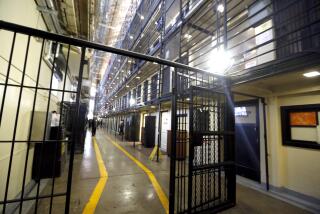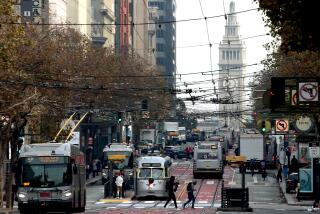Inmates go from lock-up to start-ups
SAN QUENTIN — North of Silicon Valley on a rocky promontory overlooking San Francisco Bay stands California’s oldest prison.
Inmates here are cut off from the innovation the nearby high-tech industry produces. They are not permitted on the Internet, and most have never touched a smartphone or a tablet.
But two technology veterans — Chris Redlitz and Beverly Parenti — are bringing the promise of Silicon Valley to San Quentin State Prison by creating a high-tech incubator here called the Last Mile. Its mission is to teach inmates about technology so they can forge new lives when they are released from prison.
RELATED: On Quora, San Quentin inmates freed from social media lockdown
Over the course of six months, inmates are put through a business boot camp. They brainstorm a start-up, develop a business plan and boil down their pitch to five minutes. On “Demo Day,” each inmate presents his idea to dozens of Silicon Valley investors and executives who crowd the prison chapel.
The inmates can’t actually start these companies from prison, but they are introduced to a world that would otherwise be closed to them. When paroled, Last Mile graduates are given paid internships at tech start-ups.
Five graduates of the San Quentin program are working in high tech. The program has been so successful that last month it expanded to the downtown Los Angeles Twin Towers Correctional Facility, where 15 inmates are taking part.
Tom Serres, founder and chief executive of Rally.org, a crowd-funding start-up for political, social and charitable causes in San Francisco, said he had doubts about hiring a felon. But those quickly vanished after meeting Heracio “Ray” Harts, he said. Harts, 40, was released in April after he served 81/2 years for manslaughter.
“This is a real opportunity to help somebody who most definitely deserves the opportunity to be a contributing member of society,” Serres said.
Last February, Harts stood at the prison chapel lectern — dressed in a prison-issued blue shirt and dark sweat pants with the word “prisoner” stamped on the leg and his hair in braids — pitching his idea to combat obesity in low-income communities by turning empty lots into community gardens and abandoned buildings into fitness facilities. A mobile app would help people track their fitness progress.
Today Harts has earned a spot at Rally.org as a full-time employee. Harts helps the Robert Redford Foundation, the Maker Education Initiative and the Delta Sigma Phi national fraternity with their campaigns on the website. And he’s talking to Pittsburg, Calif., officials about starting a health and fitness program in his former hometown.
“I feel like I belong here,” said Harts, sitting in a brick-and-glass walled conference room at Rally.org, in a North Face fleece jacket, his hair neatly buzzed. “I’m an entrepreneur. I work in tech. This is my evolution.”
Like many who live in wealthy Marin County, husband and wife Redlitz and Parenti often drove past San Quentin but had never set foot inside.
Then in 2011, a friend asked Redlitz, a 57-year-old entrepreneur and investor who runs the KickLabs accelerator program in San Francisco, to give a 30-minute talk on entrepreneurship at San Quentin. He was apprehensive but decided to go.
For two hours Redlitz fielded questions from inmates who he says impressed him with their passion, drive and smarts.
“These were people who have taken responsibility for what they have done and are trying to carve a path back to society,” Redlitz said.
California has one of the largest prison populations in the United States, second only to Texas, and one of the highest rates of recidivism. Within three years nearly 2 out of 3 ex-convicts commit another crime and end up back in prison. Yet the California Department of Corrections and Rehabilitation spends just 4.3% of its nearly $9-billion budget on rehabilitation.
“Those numbers really hit me,” Redlitz said. “Putting my professional investor hat on, that’s a really bad investment for taxpayers.”
So Redlitz and Parenti persuaded prison officials to let them experiment with a new model for rehabilitation that combines job training, confidence building and a bridge to the technology industry.
With California facing a deadline to ease overcrowding by reducing its prison population, more prisoners are serving longer sentences in county jails. “The goal is to offer the Last Mile in all of the L.A. County Jail facilities,” Redlitz said.
This spring, Redlitz and Parenti plan to launch the program inside several more prisons in California and one in Michigan.
“There is not a lot being offered in prison to help people build a better life,” said Caleb Hunter, 35, a former San Quentin inmate and college graduate who used to work in high tech. “The Last Mile is absolutely life changing.”
In July, Kenyatta Leal, sentenced to 25 years to life for possession of a firearm, was released from prison after serving 19 years. Two weeks later he started working as a paid intern at RocketSpace, which rents office space to start-ups. Last month Leal became a full-time employee at the San Francisco company, working in customer operations.
“Being around so many innovative people really rubs off on you,” Leal, 45, said. “I’ve always had this entrepreneurial spirit. I just used it in the wrong ways.”
Last Mile participants are assigned books on entrepreneurship; they meet with some of the authors.
They learn about the latest technology trends and how to use social media. They write down their thoughts on paper and volunteers post them on Twitter, in blog posts and on question-and-answer website Quora.
High-profile members of the tech community serve as mentors. Rapper and entrepreneur MC Hammer regularly goes to San Quentin to talk to inmates about how to rebrand themselves.
The start-up ideas that inmates come up with are rooted in their life experiences.
Tommy Winfrey, in prison for second-degree murder, is a 35-year-old self-taught artist who paints southwestern landscapes. His proposed start-up, Art Felt Creations, would help prison artists sell their work to the public and fund art programs in schools.
“The next Van Gogh or Picasso could be residing behind these very walls,” he said.
Larry Histon, 65, who had a successful career in high tech before going to prison and is serving 29 years to life for first-degree murder, says his start-up, TechSage, could reduce recidivism and keep jobs in the U.S. by training ex-convicts as mobile app developers. He says his idea could also help him get back into the industry.
Even before taking part in the Last Mile, Harts was determined to make a better life for his wife and three children. That meant breaking the cycle of crime and incarceration that has trapped family members.
Harts grew up in Pittsburg, where he began smoking pot before he was a teenager. He dealt drugs and carried a gun for protection. His younger brother and two cousins were shot and killed, and another cousin was dragged by a car and died.
After he lost a well-paying job at a refinery, his life began a downward spiral that hit rock bottom when he killed a man in 2004.
In prison, Harts studied business books and magazines. He earned a college degree. He packaged test tubes for a medical supply company. But he said his real break was the one he got through the Last Mile.
At Rally.org he has been showered with high-tech perks such as free gourmet lunches and yoga classes. But for Harts, it’s all about getting “a hands-on MBA.”
“I love understanding business. I love the energy of a start-up,” Harts said. “I love seeing the changes we are making.”






